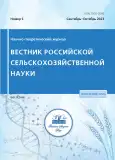Patterns for digitalization of grain crop production in the crop rotations of the central black earth region forest-steppe
- Authors: Akimenko A.S1, Sviridov V.I1, Dudkina T.A1, Dolgopolova N.V1
-
Affiliations:
- Federal State Budgetary Scientific Institution "Federal Agricultural Kursk Research Center"
- Issue: No 5 (2023)
- Pages: 4-9
- Section: Articles
- URL: https://journals.rcsi.science/2500-2082/article/view/233548
- DOI: https://doi.org/10.31857/2500-2082/2023/5/4-9
- EDN: https://elibrary.ru/XJHNQK
- ID: 233548
Cite item
Full Text
Abstract
Keywords
About the authors
A. S Akimenko
Federal State Budgetary Scientific Institution "Federal Agricultural Kursk Research Center"
Email: vniiz.sevooborot@mail.ru
V. I Sviridov
Federal State Budgetary Scientific Institution "Federal Agricultural Kursk Research Center"
T. A Dudkina
Federal State Budgetary Scientific Institution "Federal Agricultural Kursk Research Center"
N. V Dolgopolova
Federal State Budgetary Scientific Institution "Federal Agricultural Kursk Research Center"
References
- Акименко А.С. Методика использования ресурсов в земледелии на основе информационно-энергетического анализа. Курск: ЮМЭКС, 2000. 76 с.
- Альт В.В., Чекусов М.С., Исакова С.П. Применение цифровых технологий при возделывании зерновых культур. Технические культуры // Научный сельскохозяйственный журнал. 2022. №1 (2). С. 3-9. doi: 10.54016/SVITOK.2022.66.59.001
- Волынкина О.В. Предельные прибавки урожайности сельскохозяйственных культур от азота и его окупаемость на черноземе // Плодородие. 2021. № 2. С. 9-14.doi: 10.25680/S19948603.2021.119.03
- Доспехов Б.А. Методика полевого опыта: учеб. пособие. М.: Колос, 1973. 336 с.
- Косогор С. Трансформация сельского хозяйства: цифровые возможности развития // Системы безопасности. 2022. № 3. URL:https://www.secuteck.ru/articles/transformaciya-selskogo-hozyajstva-cifrovye-vozmozhnosti-razvitiya (дата обращения 15 марта 2023 года).
- Минакова О.А., Александрова Л.В., Подвигина Т.Н. Продуктивность зерносвекловичного севооборота при краткосрочном и длительном применении удобрений в ЦЧР // Земледелие. 2021. № 2. С. 18-22. doi: 10.24411/0044-3913-2021-10204
- Новичихин А.М., Чайкин В.В. Урожайность сортов ярового ячменя при различных уровнях минерального питания в сочетании со стимуляторами роста // Агрохимический вестник. 2022. №3. С. 10-16. doi: 10.24412/1029-2551-2022-3-002
- Тютюнов С.И., Солнцев П.И. Влияние интенсивности применения удобрений и средств защиты растений на урожайность культур в зернопропашном севообороте // Сахарная свекла. 2021. № 10. С. 33-36. doi: 10.25802/SB.2021.92.47.007
- Цыгуткин А.С., Азаров А.В. Изучение влияния технологий возделывания сельскохозяйственных культур и почвы, как саморазвивающейся системы, на содержание гумуса // Достижения науки и техники АПК. 2021. Т. 35. № 6. С. 44-49. doi: 10.24411/0235-2451-2021-10608
- Шабалкин А.В., Драчева М.К., Воронцов В.А., Скорочкин Ю.П. Реакция ячменя на средства интенсификации и приемы обработки чернозёмных почв в северо-восточном регионе Черноземья // Земледелие. 2022. №6. С. 41-48. doi: 10.24412/0044-3913-2022-6-41-45
- Шарков И.Н., Колбин С.А., Самохвалова Л.М. Проблема азота при использовании чернозема выщелоченного по интенсивной технологии в лесостепи Западной Сибири // Агрохимия. 2021. № 2. С. 3-10. doi: 10.31857/S0002188121020101
- Lubkowski K. Environmental impact of fertilizer use and slow release of mineral nutrients as a response to this challenge // Polish J. Chem. Technol. 2016. V. 18. P. 72-79.
- Zhang W.F., Dou Z.X., He P. et al. New technologies reduce greenhouse gas emissions from nitrogenous fertilizer in China // Proceed. Nat. Acad. Sci. USA. 2013. V. 110. № 21. P. 8375-8380.
Supplementary files










